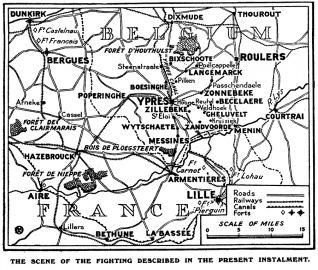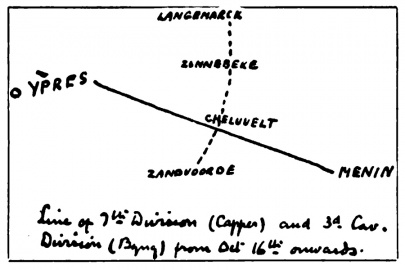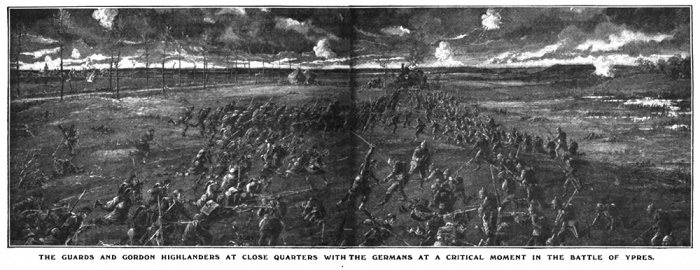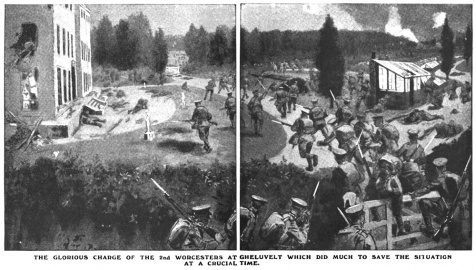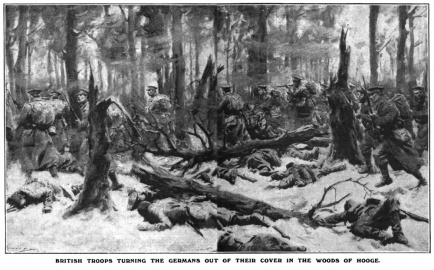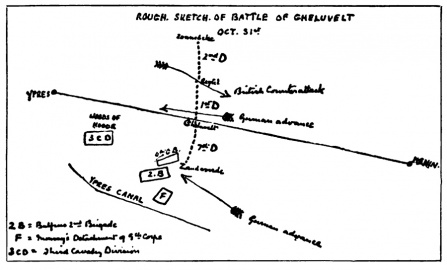The British Campaign in France (october 1916)
| << 6/21 The British Campaign in France | The British Campaign in France 8/21 >> |

(The Strand Magazine, october 1916, p. 433)
The British Campaign in France. VI. (continued) The First Battle of Ypres is the 7th article, published in october 1916, in a series of 21 articles written by Arthur Conan Doyle serialized in The Strand Magazine.
Editions
- in The Strand Magazine (october 1916 [UK]) (3 map, 3 ill.)
- in The British Campaign in France and Flanders (1916-1920, Hodder & Stoughton Ltd. [UK])
- in The British Campaign in France and Flanders (1916, George H. Doran Co. [US])
- in The British Campaign in Europe (1914-1918) (november 1928, Geoffrey Bles [UK])
Illustrations
-
The scene of the fighting described in the present instalment.
-
Line of 7th Division (Capper) and 3rd Cav. Division (Byng) from Oct 16th onwards.
-
The Guards and Gordon Highlanders at close quarters with the Germans at a critical moment in the battle of Ypres.
-
The glorious charge of the 2nd Worcesters at Gheluvelt which did much to save the situation at a crucial time.
-
British troops turning the Germans out of their cover in the woods of hooge.
-
Rough sketch of battle of Gheluvelt.
The British Campaign in France (october 1916)

(The Strand Magazine, october 1916, p. 433)
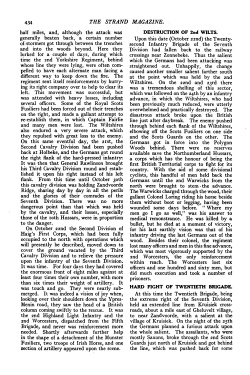
(The Strand Magazine, october 1916, p. 434)

(The Strand Magazine, october 1916, p. 435)
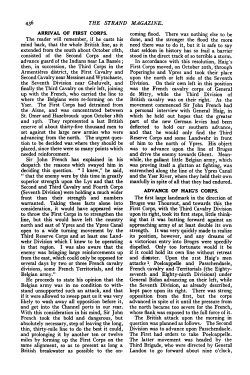
(The Strand Magazine, october 1916, p. 436)
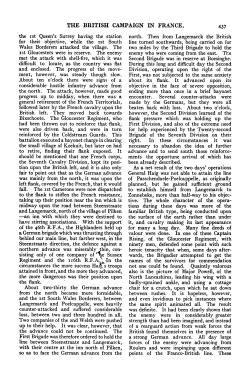
(The Strand Magazine, october 1916, p. 437)

(The Strand Magazine, october 1916, p. 438)

(The Strand Magazine, october 1916, p. 439)
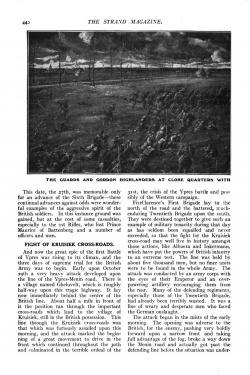
(The Strand Magazine, october 1916, p. 440)
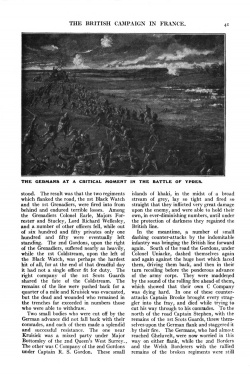
(The Strand Magazine, october 1916, p. 441)
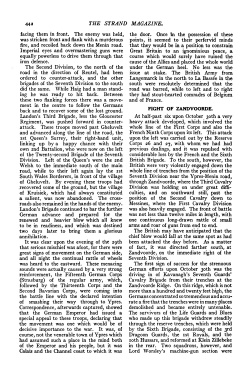
(The Strand Magazine, october 1916, p. 442)
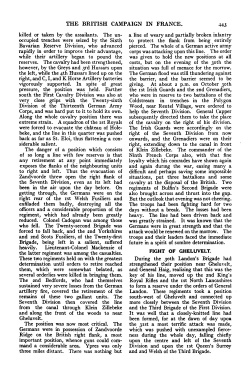
(The Strand Magazine, october 1916, p. 443)

(The Strand Magazine, october 1916, p. 444)

(The Strand Magazine, october 1916, p. 445)

(The Strand Magazine, october 1916, p. 446)
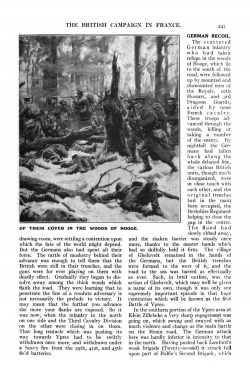
(The Strand Magazine, october 1916, p. 447)

(The Strand Magazine, october 1916, p. 448)

(The Strand Magazine, october 1916, p. 449)
Chapter VI (continued) The First Battle of Ypres
(Up to the Action of Gheluvelt, October 31.)
Desperate Attacks on Seventh Division — Destruction of 2nd Wilts Hard Fight of Twentieth Brigade — Arrival of First Corps — Advance of Haig's Corps — Fight of Pilken Inn — Bravery of Enemy — Advance of Second Division — Fight of Kruisiek Cross-Roads — Fight of Zandvoorde — Fight of Gheluvelt — Advance of Worcesters — German Recoil — General Result — A Great Crisis.
On October 21st the enemy got a true conception of the salient in front of the Seventh Division,and opened a vigorous attack, which lasted all day and assumed several different phases at different points. The feature of the morning of the 21st was the severe and, indeed, disastrous artillery fire upon Law ford's Twenty-second Brigade. The exact range of the British position seems to have been discovered with deadly results. Men, trenches, and machine-guns were all blown to pieces together. The 2nd Warwicks and the 1st Welsh Fusiliers were the two regiments upon which the storm beat hardest, and each of them had some hundred of casualties. In three days the Welsh Fusiliers, who were on the exposed left flank, lost three-quarters of their effectives, including twenty-three of their officers, and yet preserved their military spirit. It became clearer as experience accumulated that the best trenches, if they are once fairly located, can be made untenable or turned into the graves of their occupants by the use of high explosives. The German fire was so severe that it was reckoned that one hundred and twenty shells an hour into or round a trench was a not uncommon rate of fall. The 2nd Queen's Surrey also lost seven officers and many men in this day's fighting.
Desperate Attacks on Seventh Division
In the afternoon of October 21st a strong attack was made upon the Twenty-first Brigade in the centre of the line. The brigade was holding a front of two and a half miles, and, although the attack was generally beaten back, a certain number of-stormers got through between the trenches and into the woods beyond. Here they lurked for a couple of days, during which time the 2nd Yorkshire Regiment, behind whose line they were lying, were often compelled to have each alternate man facing a different way to keep down the fire. The regiment sent itself reinforcements by hurrying its right company over to help to clear its left. This movement was successful, but was attended with heavy losses, including several officers. Some of the Royal Scots Fusiliers had been forced out of their trenches on the right, and made a gallant attempt to re-establish them, in which Captain Fairlie and many men were lost. The Wiltshires also endured a very severe attack, which they repulsed with great loss to the enemy. On this same eventful day, the 21st, the Second Cavalry Division had been pushed back at Holbeke, and the Germans got round the right flank of the hard-pressed infantry. It was then that General Rawlinson brought his Third Cavalry Division round and established it upon his right instead of his left flank. From this time until October 30th this cavalry division was holding Zandvoorde Ridge, sharing day by day in all the perils and the glories of their comrades of the Seventh Division. There was no more dangerous point than that which was held by the cavalry, and their losses, especially those of the 10th Hussars, were in proportion to the danger.
On October 22nd the Second Division of Haig's First Corps, which had been fully occupied to the north with operations which will presently be described, moved down to cover the ground vacated by the Third Cavalry Division and to relieve the pressure upon the infantry of the Seventh Division. It was time. For four days they had covered the enormous front of eight miles against at least four times their own number, with more than six times their weight of artillery. It was touch and go. They were nearly sub-merged. It was indeed a vision of joy when, looking over their shoulders down the Ypres-Menin road, they saw the head of a British column coming swiftly to the rescue. It was the 2nd Highland Light Infantry and the 2nd Worcesters, dispatched from the Fifth Brigade, and never was reinforcement more needed. Shortly afterwards further help in the shape of a detachment of the Munster Fusiliers, two troops of Irish Horse, and one section of artillery appeared upon the scene.
Destruction of 2nd Wilts
Upon this date (October 22nd) the Twenty-second Infantry Brigade of the Seventh Division had fallen back to the railway crossings near Zonnebeke. Thus the salient which the Germans had been attacking was straightened out. Unhappily, the change caused another smaller salient farther south at the point which was held by the 2nd Wiltshires. On the 22nd and 23rd there was a tremendous shelling of this sector, which was followed on the 24th by an infantry advance, in which the Wiltshires, who had been previously much reduced, were utterly overwhelmed and practically destroyed. The disastrous attack broke upon the British line just after daybreak. The enemy pushed through behind each flank of the Wiltshires, elbowing off the Scots Fusiliers on one side and the Scots Guards on the other. The Germans got in force into the Polygon Woods behind. There were no reserves available save the Northumberland Hussars, a corps which has the honour of being the first British Territorial corps to fight for its country. With the aid of some divisional cyclists, this handful of men held back the Germans until the 2nd Warwicks from the north were brought to stem the advance. The Warwicks charged through the wood, their gallant Colonel Loring riding his horse beside them without boot or legging, having been wounded some days before. "Where my men go I go as well," was his answer to medical remonstrance. He was killed by a bullet, but he died at a moment of victory, for his last earthly vision was that of his infantry driving the last Germans out of the wood. Besides their colonel, the regiment lost many officers and men in this fine advance, which was most vigorously supported by the 2nd Worcesters, the only reinforcement within reach. The Worcesters lost six officers and one hundred and sixty men, but did much execution and took a number of prisoners.
Hard Fight of Twentieth Brigade
At this time the Twentieth Brigade, being the extreme right of the Seventh Division, held an extended line from Kruisiek cross-roads, about a mile east of Gheluvelt village, to near Zandvoorde, with a salient at the village of Kruisiek. On the night of the 25th the Germans planned a furious attack upon the whole salient. The assailants, who were mostly Saxons, broke through the 2nd Scots Guards just north of Kruisiek and got behind the line, which was pushed back for some distance, though Captain Paynter, with the right-hand company, held his position. A counter-attack by the Guards retook the line, together with two hundred prisoners, including seven officers. On the morning of the 26th the Germans were back on them, however, and began by blowing in the trenches of the Border Regiment south of Kruisiek. The German guns had found the exact range of the trenches, and the defenders had the same terrible and intolerable experience which had befallen some of their comrades two days before. It was simply impossible to stand up against the incessant shower of shattering shells. So great was the concussion and the nervous strain that many of the men exposed to it got completely dazed or even became delirious. Grenadiers, Scots Guards, and South Staffords, of the Twentieth Brigade, held the line until the front trenches were carried by the Germans and many of the occupants made prisoners. It was pitch-dark, and it was impossible to tell friend from foe. It was on this occasion that Lord Dalrymple, Colonel Bolton, and other officers, with some hundreds of men, fell into the hands of the enemy after a most heroic resistance to overpowering numbers and to a weight of artillery which was crushing in its effect. The King's Company of the 1st Grenadiers was isolated and in great danger, but managed to link up with the British line. The 1st South Staffords also lost some hundreds of men, and was only saved by fine handling on the part of Colonel Ovens. Kruisiek was abandoned, and a new line taken up half a mile farther back. It was a critical night, during which the energy and firmness of General Capper were splendidly employed in re-forming and stiffening his sorely-tried division. On the 26th the Twentieth Brigade, which had been so heavily hit the day before, was drawn out of the line for a rest, and the two other brigades closed up to cover a shorter line. The work of the Twentieth at Kruisiek had been magnificent, but their losses were appalling, including their Brigadier, Ruggles-Brise. Here, for the instant, we shall leave the Seventh Division, though their ordeal was by no means done, and we shall turn to those other forces which had been forming in the northern or Ypres section of the long battle lined
Arrival of First Corps
The reader will remember, if he casts his mind back, that the whole British line, as it extended from the south about October 18th, consisted of the Second Corps and the advance guard of the Indians hear La Bassée ; then, in succession, the Third Corps in the Armentières district, the First Cavalry and Second Cavalry near Messines and Wytschaete, the Seventh Division near Gheluvelt, and finally the Third Cavalry on their left, joining up with the French, who carried the line to where the Belgians were re-forming on the Yser. The First Corps had detrained from the Aisne, and was concentrated between St. Omer and Hazebrouck upon October 18th and 19th. They represented a last British reserve of about thirty-five thousand men to set against the large new armies who were advancing from the north. The urgent question to be decided was. where they should be placed, since there were so many points which needed reinforcement.
Sir John French has explained in his despatch the reasons which swayed him in deciding this question. "I knew," he said, "that the enemy were by this time in greatly superior strength upon the Lys and that the Second and Third Cavalry and Fourth Corps (Seventh Division) were holding a much wider front than their strength and numbers warranted. Taking these facts alone into consideration, it would have appeared wise to throw the First Corps in to strengthen the line, but this would have left the country north and east of Ypres and the Ypres Canal open to a wide turning movement by the Third Reserve Corps and at least one Landwehr Division which I knew to be operating in that region. I was also aware that the enemy was bringing large reinforcements up from the east, which could only be opposed for several days by two or three French cavalry divisions, some French Territorials, and the Belgian army."
He proceeds to state his opinion that the Belgian army was in no condition to with-stand unsupported such an attack, and that if it were allowed to sweep past us it was very likely to wash away all opposition before it, and get into the Channel ports in our rear. With this consideration in his mind, Sir John French took the bold and dangerous, but absolutely necessary, step of leaving the long, thin, thirty-mile line to do the best it could, and prolonging it by another ten or twelve miles by forming up the First Corps on the same alignment, so as to present as long a British breakwater as possible to the oncoming flood. There was nothing else to be done, and the stronger the flood the more need there was to do it, but it is safe to say that seldom in history has so frail a barrier stood in the direct track of so terrible a storm.
In accordance with this resolution, Haig's First Corps moved, on October 10th, through Poperinghe and Ypres and took their place upon the north or left side of the Seventh Division. On their own left in this position was the French cavalry corps of General de Mitry, while the Third Division of British cavalry was on their right. As the movement commenced Sir John French had a personal interview with General Haig, in which he held out hopes that the greater part of the new German levies had been deflected to hold our southern advance, and that he would only find the Third Reserve Corps and some Landwehr in front of him to the north of Ypres. His object was to advance upon the line of Bruges and drive the enemy towards Ghent. Mean-while, the gallant little Belgian army, which was proving itself a glutton at fighting, was entrenched along the line of the Ypres Canal and the Yser River, where they held their own manfully in spite of all that they had endured.
Advance of Haig's Corps
The first large landmark in the direction of Bruges was Thourout, and towards this the First Corps, with the Third Cavalry Division upon its right, took its first steps, little thinking that it was butting forward against an approaching army of at least double its own strength. It was very quickly made to realize its position, however, and any dreams of a victorious entry into Bruges were speedily dispelled. Only too fortunate would it be if it could hold its own line without retreat and disaster. Upon the 21st Haig's men attacked, Poelcappelle and Passchendaele, French cavalry and Territorials (the Eighty-seventh and Eighty-ninth Divisions) under General Bidon advancing on their left, while the Seventh Division, as already described, kept pace upon its right. There was strong opposition from the first, but the corps advanced in spite of it until the pressure from the north became too severe for the French, whose flank was exposed to the full force of it.
The British attack upon the morning in question was planned as follows. The Second Division was to advance upon Passchendaele. The First had orders to take Poelcappelle. The latter movement was headed by the Third Brigade, who were directed by General Landon to go forward about nine o'clock, the 1st Queen's Surrey having the station for their objective, while the 1st South Wales Borderers attacked the village. The 1st Gloucesters were in reserve. The enemy met the attack with shell-fire, which it was difficult to locate, as the country was flat and enclosed. The progress of the movement, however, was steady though slow. About ten o'clock there were signs of a considerable hostile infantry advance from the north. The attack, however, made good progress up to midday, when there was a general retirement of the French Territorials, followed later by the French cavalry upon the British left. They moved back towards Bixschoote. The Gloucester Regiment, who had been thrown out to reinforce that flank, were also driven back, and were in turn reinforced by the Coldstream Guards. This battalion executed a bayonet charge in clearing the small village of Koekuit, but later on had to retire, finding their flank exposed. It should be mentioned that one French corps, the Seventh Cavalry Division, kept its position upon the British left, and it is also only fair to point out that as the German advance was mainly from the north, it was upon the left flank, covered by the French, that it would fall. The 1st Camerons were now dispatched to the flank to stiffen the French resistance, taking up their position near the inn which is midway upon the road between Steenstraate and Langemarck, north of the village of Pilken — an inn with which they were destined to have stirring associations. With the support of the 46th R.F.A., the Highlanders held up a German brigade which was thrusting through behind our main line, but farther west, in the Steenstraate direction, the defence against a northern advance was miserably thin, consisting only of one company of the Sussex Regiment and the 116th R.F.A. In the circumstances the more success Hairs troops attained in front, and the more they advanced, the more dangerous was their position upon the flank.
About two-thirty the German advance from the north became more formidable, and the 1st South Wales Borderers, between Langemarck and Poelcappelle, were heavily counter-attacked and suffered considerable loss, between two and three hundred in all. Two companies of the 2nd Welsh were pushed up to their help. It was clear, however, that the advance could not be continued. The First Brigade was therefore ordered to hold the line between Steenstraate and Langemarck, with their centre at the inn north of Pilken, so as to face the German advance from the north. Then from Langemarck the British line turned southwards, being carried on for two miles by the Third Brigade to hold the enemy who were coming from the east. The Second Brigade was in reserve at Boesinghe. During this long and difficult day the Second Division, operating upon the right of the First, was not subjected to the same anxiety about its flank. It advanced upon its objective in the face of severe opposition, ending more than once in a brief bayonet encounter. Several counter-attacks were made by the Germans, but they were all beaten back with loss. About two o'clock, however, the Second Division learned of the flank pressure which was holding up the First Division, and also of the extreme need for help experienced by the Twenty-second Brigade of the Seventh Division on their right. In these circumstances it was necessary to abandon the idea of further advance and to send south those reinforcements the opportune arrival of which has been already described.
As a net result of the two days' operations General Haig was not able to attain the line of Passchendaele-Poelcappelle, as originally planned, but he gained sufficient ground to establish himself from Langemarck to Zonnebeke, more than half-way to his objective. The whole character of the operations during these days was more of the familiar British type, being conducted upon the surface of the earth rather than under it, and cavalry making its last appearance for many a long day. Many fine deeds of valour were done. In one of these Captain Rising, of the Gloucester Regiment, with ninety men, defended some point with such heroic tenacity that when, some days afterwards, the Brigadier attempted to get the names of the survivors for commendation not one could be found. Quaintly valorous also is the picture of Major Powell, of the North Lancashires, leading his wing with a badly-sprained ankle, and using a cottage chair for a crutch, upon which he sat down between rushes. It is hopeless, however, and even invidious to pick instances where the same spirit animated all. The result was definite. It had been clearly shown that the enemy were in considerably greater strength than had been imagined, and instead of a rearguard action from weak forces the British found themselves in the presence of a strong German advance. All day large forces of the enemy, were advancing from Roulers and were impinging upon different points of the Franco-British line. These troops were composed of partially-trained men, volunteers and reservists, but they attacked with the utmost determination, and endured heavy losses with great bravery. It is a remarkable proof of the elaborate preparations for war made by Germany that, behind all their original gigantic array, they still had ready within the country sufficient arms and uniforms to fit out these five new army corps. He who plans finds it easy to prepare, and whoever will compare this profusion of munitions in Germany with the absolute lack of them in the Allied countries will have no further doubt as to which Government conspired against the peace of the world.
On this day, October 21st, Sir John French began to feel that there were new factors in his front. In the evening, at a meeting with Haig and Rawlinson, he discussed the unexpected strength of the German reinforcements and showed that the scheme of an advance upon Bruges would become impossible in the face of such numbers. Intelligence reports indicated that there was already a German army corps in front of each British division. General Joffre had promised considerable French reinforcements upon October 24th, and all that could be clone was for the British troops to hold their ground to the last man and to resist every pressure until the equality of the forces could be restored. Could they hold the line till then ? That was the all-important question.
October 22nd was the first day of that long ordeal of incessant attacks which the First Corps was called upon to endure, until by constant attrition it had become almost as worn as its neighbour to the south, the Seventh Division. On this day the German attack, which had not yet attained the full volume of later days, spent itself here and there along the extended lines. Only at one point did the enemy have some success, which, however, was the prelude to disaster.
Fight of Pilken Inn
The line from Steenstraate to Langemarck, which defended the British left flank, was held by the First Brigade, the Scots Guards upon the extreme left, then the Cameron Highlanders, and the Black Watch in reserve. In the middle of the line north of Pilken was a solitary inn, already mentioned, round which trenches had been cut in horse-shoe fashion, the concavity of the shoe pointing southwards. This point marked the junction between the Camerons and the Scots Guards. About 3 p.m. this position was driven in and captured by a sudden and determined advance of the enemy. The German charge was a fine feat of arms, for it was carried out largely by Einjahrige, who may be roughly compared to the Officers' Training Corps of our British system. These high-spirited lads advanced singing patriotic songs, and succeeded in carrying the trenches in the face of soldiers who are second to none in the British Army — soldiers, too, who had seen much service, while the German cadets were new to the work. The performance was much appreciated by British officers and men.
The Black Watch endeavoured without success to restore the line, and the 1st Northamptons were called upon from divisional reserve, while from all parts troops converged towards the gap. On the arrival of the Northamptons they pushed up towards the interval which now existed between the Scots Guards and the remains of the Camerons, but found the gap broader than had been thought, and strongly occupied. It was then evening, and it was thought best to delay the counter-attack until morning and so have time to bring up reinforcements. The 1st North Lancashires and the 2nd South Staffords were accordingly ordered up, together with the 1st Queen's Surrey and the 2nd Rifles, the whole operation being under the immediate command of General Bulfin. The advance began at six in the morning, over very difficult ground which had been barb-wired during the night. The progress was slow but steady, and at eleven o'clock an assault upon the inn was ordered. The position was critical, since the enemy was now firmly lodged in the very centre of the flank of the British position, and was able to enfilade all the trenches of the First Division. The Queen's Surrey, the 2nd King's Royal Rifles, and the 1st North Lancashires charged home with splendid energy, capturing the inn and the trenches round it, besides releasing sixty Camerons and capturing over five hundred prisoners. The trenches were carried by the North Lancashires, led by Major Carter. It was the second time within six weeks that this battalion had made a decisive bayonet charge. The price paid was six officers and one hundred and fifty men. The inn itself was rushed by Captain Creek's company of the Queen's, while Major Watson, of the same regiment, organized the final advance. The fighting at this point was not finished for the day. In the late evening the enemy, with fine tenacity of purpose, attacked the inn once more and drove the Queen's Surrey out of a salient. The line was then straightened on each side of the inn and remained firm. Both the attack on the inn and the defence of the line were splendidly supported by the field artillery.
Whilst the First Brigade had in this fashion got into and out of a dangerous position, there had been a severe attack upon two regiments of Landon's Third Brigade stationed at Langemarck. The defending units were the 2nd Welsh Regiment and the 1st Gloucesters. Aided by a strong artillery backing, they beat off these attacks and inflicted a very heavy loss upon the enemy. The Allied line to the north was solid and unbroken.
Bravery of enemy
The British losses during these operations of the First Corps up to October 24th amounted to one thousand five hundred men, while those of the Germans were exceedingly heavy. These inexperienced troops advanced with an indiscriminating enthusiasm which exposed them to severe retaliation. It is doubtful if at any time in the campaign the British fire found so easy a mark. One thousand five hundred dead were counted in the vicinity of Langemarck, and the total loss (including over six hundred prisoners) could not have been less than ten thousand men. Correspondence afterwards captured showed that the Twenty-third Reserve Corps sustained such losses that for a time at least it was out of action. The Twenty-seventh Reserve Corps was also hard hit. A letter from a soldier in the 246th Regiment mentions that only eighty men were left of his battalion after the action of the 24th.
On October 24th and 25th the arrival of French reinforcements allowed the British to shorten up their defensive line, which had been unduly extended. The Seventeenth Division of the Ninth French Army Corps took over the line of the Second Division, which was drawn back to St. Jean, and in turn took over part of the front of the Seventh Division. French Territorial troops, under General de Mitry, relieved the First British Division on the line Hannebeke — Langemarck — Steenstraate. The First Division was drawn back to Zillebeke.
Advance of Second Division
Meantime the Second Division, having the French Ninth Corps upon its left and the Seventh Division upon its right, made an attack towards Bacelaer, taking two guns and some prisoners. This advance was renewed upon the 26th, this being the day upon which, as already described, the Germans pushed back the Twentieth Brigade of the Seventh Division at the Kruisiek salient, which brought the Second Division to a standstill.
In this movement forward of the Second Division from October 24th to 26th the Guards' Fourth Brigade were on the right, the Sixth Brigade on the left, with the French to the left of them. The Fifth Brigade were mainly in reserve. Two small villages were taken by storm, the Germans being driven out of loopholed houses, though at a considerable cost of officers and men. It was in this operation that Colonel Bannatyne, the gallant leader of the 1st King's Liverpool, was killed. Ten other officers and several hundred men of this corps were killed or wounded. The 1st Berkshires, fighting to the left of the King's, shared in its losses and in its success. The Irish Guards were held up before Reutel and separated from the rest of the force, but managed to extricate themselves after some anxious hours.
On October 27th Sir John French came in person to Hooge, at the rear of the fighting line, and inquired into the state of the hard-pressed troops. He found the Seventh to be now such a skeleton division that it was thought best to join it with Haig's First Corps, forming one single command.
The attendant Third Cavalry Division was also attached to the First Corps. These readjustments took place upon October 27th. They were, of course, of a temporary character until the eagerly-awaited Eighth Division should arrive and so give General Rawlinson a complete Fourth Corps. At present there was a very immediate prospect that half of it might be annihilated before the second half appeared. The general arrangement of this section of the battlefield was now as depicted in the accompanying diagram, the Seventh Division being entirely south of the Ypres-Menin roadway.
This date, the 27th, was memorable only for an advance of the Sixth Brigade — these continual advances against odds were wonderful examples of the aggressive spirit of the British soldiers. In this instance ground was gained, but at the cost of some casualties, especially to the 1st Rifles, who lost Prince Maurice of Battenberg and a number of officers and men.
Fight of Kruisiek Cross-Roads
And now the great epic of the first Battle of Ypres was rising to its climax, and the three days of supreme trial for the British Army was to begin. Early upon October 29th a very heavy attack developed upon the line of the Ypres-Menin road. There is a village named Gheluvelt, which is roughly half-way upon this tragic highway. It lay now immediately behind the centre of the British line. About half a mile in front of it the position ran through the important cross-roads which lead to the village of Kruisiek, still in the British possession. This line through the Kruisiek cross-roads was that which was furiously assailed upon this morning, and the attack marked the beginning of a great movement to drive in the front which continued throughout the 30th and culminated in the terrible ordeal of the 31st, the crisis of the Ypres battle and possibly of the Western campaign.
FitzClarence's First Brigade lay to the north of the road and the battered, much-enduring Twentieth Brigade upon the south. They were destined together to give such an example of military tenacity during that day as has seldom been equalled and never exceeded, so that the fight for the Kruisiek cross-road may well live in history amongst those actions, like Albuera and Inkermann, which have put the powers of British infantry to an extreme test. The line was held by about five thousand men, but no finer units were to be found in the whole Army. The attack was conducted by an army corps with the eyes of their Emperor and an over-powering artillery encouraging them from the rear. Many of the defending regiments, especially those of the Twentieth Brigade, had already been terribly wasted. It was a line of weary and desperate men who faced the German onslaught.
The attack began in the mists of the early morning. The opening was adverse to the British, for the enemy, pushing very boldly forward upon a narrow front and taking full advantage of the fog, broke a way down the Men in road and actually got past the defending line before the situation was understood. The result was that the two regiments which flanked the road, the 1st Black Watch and the 1st Grenadiers, were fired into from behind and endured terrible losses. Among the Grenadiers Colonel Earle, Majors Forrester and Stucley, Lord Richard Wellesley, and a number of other officers fell, while out of six hundred and fifty privates only one hundred and fifty were eventually left standing. The 2nd Gordons, upon the right of the Grenadiers, suffered nearly as heavily, while the 1st Coldstream, upon the left of the Black Watch, was perhaps the hardest hit of all, for at the end of that dreadful day it had not a single officer fit for duty. The right company of the 1st Scots Guards shared the fate of the Coldstream. The remains of the line were pushed back for a quarter of a mile and Kruisiek was evacuated, but the dead and wounded who remained in the trenches far exceeded in numbers those who were able to withdraw.
Two small bodies who were cut off by the German advance did not fall back with their comrades, and each of them made a splendid and successful resistance. The one near Kruisiek was a mixed party under Major Bottomley of the 2nd Queen's West Surrey. The other was C Company of the 2nd Gordons under Captain R. S. Gordon. These small islands of khaki, in the midst of a broad stream of grey, lay so tight and fired so straight that they inflicted very great damage upon the enemy, and were able to hold their own, in ever-diminishing numbers, until under the protection of darkness they regained the British line.
In the meantime, a number of small dashing counter-attacks by the indomitable infantry was bringing the British line forward again. South of the road the Gordons, under Colonel Uniacke, dashed themselves again and again against the huge host which faced them, driving them back, and then in their turn recoiling before the ponderous advance of the army corps. They were maddened by the sound of the rolling fire ahead of them, which showed that their own C Company was dying hard. In one of these counter-attacks Captain Brooke brought every straggler into the fray, and died while trying to cut his way through to his comrades. To the north of the road Captain Stephen, with the remains of the 1st Scots Guards, threw them. selves upon the German flank and staggered it by their fire. The Germans, who had almost reached Gheluvelt, were now worried in this way on either flank, while the 2nd Borders and the Welsh Borderers with the rallied remains of the broken regiments were still facing them in front. The enemy was held, was stricken front and flank with a murderous fire, and recoiled back down the Menin road. Imperial eyes and overmastering guns were equally powerless to drive them through that iron defence.
The Second Division, to the north of the road in the direction of Reutel, had been ordered to counter-attack, and the other brigades of the Seventh Division to the south did the same. While Haig had a man standing he was ready to hit back. Between these two flanking forces there was a movement in the centre to follow the Germans back and to recover some of the lost ground. Landon's Third Brigade, less the Gloucester Regiment, was pushed forward in counter-attack. These troops moved past Gheluvelt and advanced along the line of the road, the 1st Queen's Surrey, their right-hand unit, linking up by a happy chance with their own 2nd Battalion, who were now on the left of the Twenty-second Brigade of the Seventh Division. Left of the Queen's were the and Welsh to the immediate south of the main road, while to their left again lay the 1st South Wales Borderers, in front of the village of Gheluvelt. By evening these troops had .recovered some of the ground, but the village of Kruisiek, which had always constituted a salient, was now abandoned. The cross-roads also remained in the hands of the enemy. Landon's Brigade continued to bar the further German advance and prepared for the renewed and heavier blow which all knew to be in readiness, and which was destined two days later to bring them a glorious annihilation.
It was clear upon the evening of the 29th that serious mischief was afoot, for there were great signs of movement on the German side, and all night the continual rattle of wheels was heard to the eastward. These menacing sounds were actually caused by a very strong reinforcement, the Fifteenth German Corps (Strasburg) of the regular army, which, followed by the Thirteenth Corps and the Second Bavarian Corps, were coming into the battle line with the declared intention of smashing their way through to Ypres. Correspondence, afterwards captured, showed that the German Emperor had issued a special appeal to these troops, declaring that the movement was one which would be of decisive importance to the war. It was, of course, not the venerable town of Ypres which had assumed such a place in the mind both of the Emperor and his people, but it was Calais and the Channel coast to which it was the door. Once In the possession of these points, it seemed to their perfervid minds that they would be in a position to constrain Great Britain to an ignominious peace, a course which would surely have ruined the cause of the Allies and placed the whole world under the German heel. No less was the issue at stake. The British Army from Langemarck in the north to La Bass& in the south were resolutely determined that the road was barred, while to left and to right they had stout-hearted comrades of Belgium and of France.
Fight of Zandvoorde
At half-past six upon October 30th a very heavy attack developed, which involved the whole line of the First Corps and also the French Ninth Corps upon its left. This attack upon the left was carried out by the Reserve Corps 26 and 27, with whom we had had previous dealings, and it was repulsed with considerable loss by the French and the Sixth British Brigade. To the south, however, the British were very violently engaged down the whole line of trenches from the position of the Seventh Division near the Ypres-Menin road, through Zandvoorde, where the Third Cavalry Division was holding on under great difficulties, and on southward still, past the position of the Second Cavalry down to Messines, where the First Cavalry Division was also heavily engaged. The front of battle was not less than twelve miles in length, with one continuous long-drawn rattle of small arms and roar of guns from end to end.
The British may have anticipated that the chief blow would fall at the same spot as had been attacked the day before. As a matter of fact, it was directed farther south, at Zandvoorde, on the immediate right of the Seventh Division.
The first sign of success for the strenuous German efforts upon October 30th was the driving in of Kavanagh's Seventh Guards' Cavalry Brigade from their trenches at the Zandvoorde Ridge. On this ridge, which is not more than a hundred and twenty feet high, the Germans concentrated so tremendous and accurate a fire that the trenches were in many places demolished and became entirely untenable. The survivors of the Life Guards and Blues who made up this brigade withdrew steadily through the reserve trenches, which were held by the Sixth Brigade, consisting of the 3rd Dragoon Guards, the 1st Royals, and the 10th Hussars, and reformed at Klein Zillebeke in the rear. Two squadrons, however, and Lord Worsley's machine-gun section were killed or taken by the assailants. The unoccupied trenches were seized by the Sixth Bavarian Reserve Division, who advanced rapidly in order to improve their advantage, while their artillery began to pound the reserves. The cavalry had been strengthened, however, by the Greys and 3rd Hussars upon the left, while the 4th Hussars lined up on the right, and C, I, and K Horse Artillery batteries vigorously supported. In spite of great pressure, the position was held. Farther south the First Cavalry Division was also at very close grips with the Twenty-sixth Division of the Thirteenth German Army Corps, and was hard put to it to hold its own. Along the whole cavalry position there was extreme strain. A squadron of the 1st Royals were forced to evacuate the château of Holebeke, and the line in this quarter was pushed back as far as St. Eloi, thus flattening a considerable salient.
The danger of a position which consists of so long a line with few reserves is that any retirement at any point immediately exposes the flanks of the neighbouring units to right and left. Thus the evacuation of Zandvoorde threw open the right flank of the seventh Division, even as its left had been in the air upon the day before. On getting through, the Germans were on the right rear of the 1st Welsh Fusiliers and enfiladed them badly, destroying all the officers and a considerable proportion of the regiment, which had already been greatly reduced. Colonel Cadogan was among those who fell. The Twenty-second Brigade was forced to fall back, and the 2nd Yorkshires and 2nd Scots Fusiliers, of the Twenty-first Brigade, being left in a salient, suffered heavily. Lieutenant-Colonel Mackenzie of the latter regiment was among the casualties. These two regiments held on with the greatest determination until orders to retire reached them, which were somewhat belated, as several orderlies were killed in bringing them. The 2nd Bedfords, who had themselves sustained very severe losses from the German artillery fire, covered the retirement of the remains of these two gallant units. The Seventh Division then covered the line from the canal through Klein Zillebeke and along the front of the woods to near. Gheluvelt.
The position was now most critical. The Germans were in possession of Zandvoorde Ridge on the British right flank, a most important position, whence guns could command a considerable area. Ypres was only three miles distant. There was nothing but a line of weary and partially broken infantry to protect the flank from being entirely pierced. The whole of a German active army corps was attacking upon this line. The order was given to hold the new positions at all costs, but on the evening of the 30th the situation was full of menace for the morrow. The German flood was still thundering against the barrier, and the barrier seemed to be giving. At about 2 p.m. on October 30th the 1st Irish Guards and the 2nd Grenadiers, who were in reserve to two battalions of the Coldstream in trenches, in the Polygon Wood, near Reutel Village, were ordered to help the Seventh Division. General Capper subsequently directed them to take the place of the cavalry on the right of his division. The Irish Guards were accordingly on the right of the Seventh Division from now onwards, and the Grenadiers were on their right, extending down to the canal in front of Klein Zillebeke. The commander of the Ninth French Corps also, with that fine loyalty which his comrades have shown again and again during the war, easing many a difficult and perhaps saving some impossible situations, put three battalions and some cavalry at the disposal of the British. Two regiments of Bulfin's Second Brigade were also brought across and thrust into the gap. But the outlook that evening was not cheering. The troops had been fighting hard for two days without a break. The losses had been heavy. The line had been driven back and was greatly strained. It was known that the Germans were in great strength and that the attack would be renewed on the morrow. The troops and their leaders faced the immediate future in a spirit of sombre determination.
Fight of Gheluvelt
During the 30th Landon's Brigade had strengthened their position near Gheluvelt, and General Haig, realizing that this was the key of his line, moved up the 2nd King's Royal Rifles and the 1st North Lancashires to form a reserve under the orders of 'General Landon. These regiments took a position south-west of Gheluvelt and connected up more closely between the Seventh Division and the Third Brigade of the First Division. It was well that a closely-knitted line had been formed, for at the dawn of day upon the 31st a most terrific attack was made, which was pushed with unexampled fierceness during the whole day, falling chiefly upon the centre and left of the Seventh Division and upon the 1st Queen's Surrey and 2nd Welsh of the Third Brigade.
A weak point developed, unfortunately, in the front line, for the Seventh Division in its enfeebled condition was further weakened by forming somewhat of a salient in the Kruisiek direction. They behaved with all their usual magnificent gallantry, but they were not numerous enough to hold the ground. The line was broken and the remains of the 2nd Royal Scots Fusiliers, after being exposed to heavy fire from 5,30 a.m., were outflanked a n d surrounded in the early afternoon. The bulk of the survivors of this battalion had been sent to reinforce the line elsewhere, but the remainder, some sixty in number, were killed, wounded, or taken, including their gallant colonel, Baird Smith, who had been hit the day before. The Picton tradition which disregards wounds unless they are absolutely crippling was continually observed by these stern soldiers.
The left wing of the Seventh Division began to retire, and the 1st Queen's Surrey upon the right of the Third Brigade fell back in conformity. It was a great morning in the history of this regiment, as the two battalions had fought side by side, and their colonels, Pell and Coles, had both fallen in the action.
The line of the Third Brigade had been drawn up across the Menin road some four hundred yards to the east of the village. The road itself was held by the 2nd Welsh Regiment, supported by the 54th Battery R.F.A. (Major Peel), which was immediately behind the village. Both the battalion and the battery fought desperately in a most exposed situation. The Welsh Regiment were driven out of their trenches by a terrific shell-fire followed by an infantry attack. They lost during the day nearly six hundred men, with sixteen officers, killed, wounded, or missing. Colonel Morland was killed and Major Prichard badly wounded. Finally, after being pushed back, holding every possible point, they formed up under Captain Rees across the open in a thin skirmishing line to cover the battery, which was doing great work by holding back the German advance. One German gun was in action upon the Menin road. Lieutenant Blewitt took a British gun out on to the bare road to face it, and a duel ensued at five hundred yards, which ended by the German gun being knocked out at the third shot by a direct hit.
When the First Division at the centre of the British line were driven in, as already described, and the Seventh Division were pushed back into the woods, the situation became most critical, for there was a general retirement, with a victorious enemy pressing swiftly on upon the British centre. The men behaved splendidly, and the officers kept their heads, taking every opportunity to form up a new line. The 2nd Rifles and 1st North Lancashires in immediate support of the centre did all that men could to hold it firm. The German artillery lengthened their range as the British fell back, and the infantry, with their murderous quick-firers scattered thickly in the front line, came rapidly on. Communications were difficult, and everything for a time was chaos and confusion. It looked for an hour or two as if Von Deimling, the German leader, might really carry out his War Lord's command and break his road to the sea. It was one of the decisive moments of the world's history, for if the Germans at that period had seized the Channel ports, it is difficult to say how disastrous the result might have been both to France and to the British Empire. At that moment of darkness and doubt a fresh misfortune, which might well have proved over-whelming, came upon the hard-pressed forces. About one-thirty a shell exploded in the headquarters at the château of Hooge, and both General Lomax, of the First Division, and General Munro, of the Second, were put out of action, the first being wounded and the second rendered unconscious by the shock. It was a brain injury to the Army, and a desperately serious one, for besides the two divisional commanders the single shell had killed or wounded Colonels Kerr and Perceval, Major Paley, Captains Ommany and Trench, and Lieutenant Gifford. General Landon, of the Third Brigade, took the command of the First Division at a moment's notice, and the battle went forward. A line was hurriedly formed, men digging as for their lives, whilst broken units threw themselves down to hold off the rolling grey wave that thundered behind. The new position was three-quarters of a mile back and about four hundred yards in advance of Veldhoek, which is the next village down the Ypres road. The Seventh Division had also been rolled back, but the fiery Capper, their divisional chief, who has been described as a British Samurai, was everywhere among his regiments, re-forming and bracing them. The British soldiers, with their incomparable regimental officers, rose to the crisis, whilst General Haig was behind the line at Hooge, directing and controlling, like a great engineer who seeks to hold a dam which carries an overpowering head of water. By three o'clock the new line was firmly held.
Advance of Worcesters
Now General Haig, seeking round for some means of making a counter-attack, perceived that on his left sank he had some reserve troops who had been somewhat clear of the storm and might he employed. The 2nd Worcesters were ordered to advance upon Gheluvelt. On that flank the troops had not joined in the retirement, and, including the South Wales Borderers of the Third Brigade, were still in their original trenches, being just north of the swathe that had been cut in the British line, and just south of where the Second Division extended to cracking point, with one man often for every eight or nine feet, and no supports, were defending the left flank of the Army.
When the village of Gheluvelt and the trenches to the north of it had been captured by the enemy, a gap had been left of about five hundred yards between the northern edge of the village and these South Wales Borderers. This gap the and Worcesters were ordered to fill. They were in reserve at the time in the south-west corner of the Polygon Wood, but on being called upon they made a brilliant advance under Major Hankey. One company (A) was detached to guard the right flank of the advance. The other three companies came on for a thousand yards. At one point they had to cross two hundred and twenty yards of open under heavy shrapnel-fire. One hundred men fell, but the momentum of the charge was never diminished. Their rapid and accurate fire drove back the German infantry, while their open order formation diminished their own losses. Finally they dashed into the trenches and connected up the village with the line of the Welsh Borderers. Their right platoons, under Captain Williams, held the village until nearly midnight. Altogether the advance cost the battalion one hundred and eighty-seven casualties, including three officers, out of five hundred and fifty who were in the ranks that day. Up to dusk the Worcesters were exposed to heavy shrapnel-fire, and small detached parties of the enemy came round their right flank, but their position was strengthened and strongly held until the final readjustment of the line. It was a fine advance at a critical moment, and did much to save the situation. The whole movement was strongly supported by the guns of the 42nd R.F.A. and by some of the 1st Scots Guards upon the left of the Welsh Borderers.
It has been stated that a line had been formed near Veldhoek, but this difficult operation was not performed in an instant, and was rather the final equilibrium established after a succession of oscillations. The British were worn to a shadow. The 2nd Queen's had two officers and sixty men left that night, the 2nd Welsh had three officers and ninety-three men. Little groups, who might have been fitted into a large-sized drawing-room, were settling a contention upon which the fate of the world might depend. But the Germans also had spent all their force. The rattle of musketry behind their advance was enough to tell them that the British were still in their trenches, and the guns were for ever playing on them with deadly effect. Gradually they began to dissolve away among the thick woods which flank the road. They were learning that to penetrate the line of a resolute adversary is not necessarily the prelude to victory. It may mean that the further you advance the more your flanks are exposed. So it was now, when the infantry to the north on one side and the Third Cavalry Division on the other were closing in on them. That long tentacle which was pushing its way towards Ypres had to be swiftly withdrawn once more, and withdrawn under a heavy fire from the 29th, 41st, and 45th field batteries.
German Recoil
The scattered German infantry who had taken refuge in the woods of Hooge, which lie to the south of the road, were followed up by mounted and dismounted men of the Royals, 10th Hussars, and 3rd Dragoon Guards, to by some French cavalry. These troops advanced through the woods, killing or taking a number of the enemy. By nightfall the Germans had fallen back along the whole debated line, the various British units, though much disorganized, were in close touch with each other, and the original trenches had in the main been occupied, the Berkshire Regiment helping to close the gap in the centre. The flood had slowly ebbed away, and the shaken barrier was steady once more, thanks to the master hands which had so skilfully held it firm. The village of Gheluvelt remained in the hands of the Germans, but the British trenches were formed to the west of it, and the road to the sea was barred as effectually as ever. Such, in brief outline, was the action of Gheluvelt, which may well be given a name of its own, though it was only one supremely important episode in that huge contention which will be known as the first Battle of Ypres.
In the southern portion of the Ypres area at Klein Zillebeke a very sharp engagement was going on, which swung and swayed with as much violence and change as the main battle on the Menin road. The German attack here was hardly inferior in intensity to that in the north. Having pushed back Lawford's weak brigade (Twenty-second) it struck full upon part of Bulfin's Second Brigade, which had been detached from the First Division and sent to cover the right of the Seventh Division. Its own left was now exposed and its situation for a time was critical. The German advance was sudden and impetuous, coming through a wood which brought the dense mass of the enemy's leading formation almost unseen right up to the British line. The position of the Second Brigade was pierced, and the two regiments present, the 2nd Sussex and the 1st Northamptons, together with the 2nd Gordons, were driven back with loss. Their brigadier rallied them some hundreds of yards to the rear, where they formed up into a skirmish line in the open, and, though unable to advance, kept back the Germans with their rifle-fire. The losses still continued, however, and the enemy came on again and again with numbers which seemed inexhaustible. Suddenly there was a charging yell from behind a low slope covering the rear, and over the brow there appeared some three hundred survivors of the 2nd Gordons, rushing at full speed with fixed bayonets. At the same moment the dismounted troopers of the Sixth Cavalry Brigade and a company of sappers ran forward to join in the charge. The whole British force was not one to three of its opponents, but as the reinforcing line swept on, cheering with all its might, the survivors of the hard-pressed brigade sprang up with a shout and the united wave burst over the Germans. Next moment they had broken and were flying for their lives through the Zwartelen Wood. The pursuit lasted for some distance, and a great number of the enemy were bayoneted, while more than five hundred were taken prisoners.
General Result
There have been few more critical occasions in the British operations than this action upon October 31st, when the Germans so nearly forced their way to Ypres. It is the peculiarity of modern warfare that, although vast armies are locked in a close struggle, the number of men who can come into actual contact at any one point is usually far more limited than in the old days, when each host could view the other from wing to wing. Thus the losses in such an action are small as compared with the terrific death-roll of a Napoleonic battle. On the other hand, when the operations are viewed broadly and one groups a series of actions into one prolonged battle, like the Aisne or Ypres, then the resulting losses become enormous. The old battle was a local conflagration, short and violent. The new one is a widespread smoulder, breaking here and there into flame. In this affair of Gheluvelt the casualties of the British did not exceed two thousand or three thousand, while those of the Germans, who were more numerous and who incurred the extra loss which falls upon the attack, could not have been less than twice that figure. One thousand five hundred dead were actually picked up and six hundred prisoners were taken. Some hundreds of prisoners were also taken by the enemy. The British artillery, which worked desperately hard all day, had many losses both upon the 30th and the 31st. The 12th Battery R.F.A. had all its guns silenced but one, and many others were equally hard hit.
On the night of the 31st considerable French reinforcements began to arrive, and it was high time that they did so, for the First Corps, including the Seventh Division, were likely to bleed to death upon the ground that they were holding. It had stood the successive attacks of four German corps, and it had held its line against each of them. But its own ranks had been grievously thinned and the men were weary to death. The strain, it should be added, was equally great upon the Ninth French Corps to the north, which had its own set of assailants to contend with. Now that, the line of the Yser, so splendidly guarded by the Belgians, had proved to be impregnable, and that the French from Dixmude in the north had repulsed all attacks, the whole German advance upon Calais, for which Berlin was screaming, was centred upon the Ypres lines. It was time, then, that some relief should come to the hard-pressed troops. For several days the French on the right and the left took the weight of the attack upon themselves, and although the front was never free from fighting, there was a short period of comparative rest for Haig's tired men. In successive days they had lost Kruisiek, Zandvoorde, and Gheluvelt, but so long as they held the semicircle of higher ground which covers Ypres these small German gains availed them nothing.
A Great Crisis
Looking back at the three actions of the 29th, 30th, and especially of the 31st of October, one can clearly perceive that it was the closest thing to a really serious defeat which the Army has had since Le Cateau. If the Germans had been able to push home their attack once again, it is probable that they would have taken Ypres, and that the results would have been most serious. Sir John French is reported as having said that there was no time in the Mons retreat when he did not see his way, great as were his difficulties, but that there was a moment upon October 31st when he seemed to be at the end of his resources. To Sir John at Ypres converged all the cries for succour, and from him radiated the words of hope and encouragement which stiffened the breaking lines. To him and to his untiring lieutenant, Douglas Haig, the Empire owed more that day than has ever been generally realized. The latter was up to the firing line again and again rallying the troops. The sudden removal of the two divisional commanders of the First Corps was a dreadful blow at such a moment, and the manner in which General Landon, of the Third Brigade, took over the command of the First Division at a moment's notice was a most noteworthy performance. The fact that three divisions of infantry with brigades which resembled battalions, and battalions which were anything from companies to platoons, destitute of reserves save for a few dismounted cavalry, barred the path to a powerful German army, is one of the greatest feats of military history. It was a very near thing. There was a time, it is said, when the breech-blocks had actually been taken from the heavy guns in order to disable them, and some of the artillery had been passed back through Ypres. But the line held against all odds, as it has done so often in the past. The struggle was not over. For a fortnight still to come it was close and desperate. But never again would it be quite so perilous as on that immortal last day of October, when over the green Flemish meadows, beside the sluggish watercourses, on the fringes of the old-world villages, and in the heart of the autumn-tinted woods, two great Empires fought for the mastery.
Such was the British epic. There was another upon our left which was no less glorious, and which will be celebrated by the poets and historians of the lands to which the victors belong. It will tell of the glorious stand during this critical ten days of the Belgians, so weary, so battered, and yet so indomitable. It will tell how they made head against the hosts of the Duke of Würtemberg, and how in the end they flooded their own best land with the salt water which would sterilize it in order to cover their front. It will tell also of the splendid Frenchmen who fought at Dixmude, of Ronarch with his invincible marines, and of Grossetti, the fat and debonair, seated in an armchair in the village street and pointing the road to victory with his cane. Not least, perhaps, in that epic will be the tale of the British monitors who, with the deadly submarines upon one side of them and the heavy German batteries upon the other, ran into the Flemish coast and poured their fire upon the right flank of the attacking Germans. Ten days the great battle swung and swayed, and then here as at Ypres the wave of the invaders ebbed, or reached their definite flood. It would be an ungenerous foe who would not admit that they had fought' bravely and well. Not all our hatred of their national ideals 'nor our contempt for their crafty misleaders can prevent us from saluting those German officers and soldiers who poured out their blood like water in the attempt to do that which was impossible.
